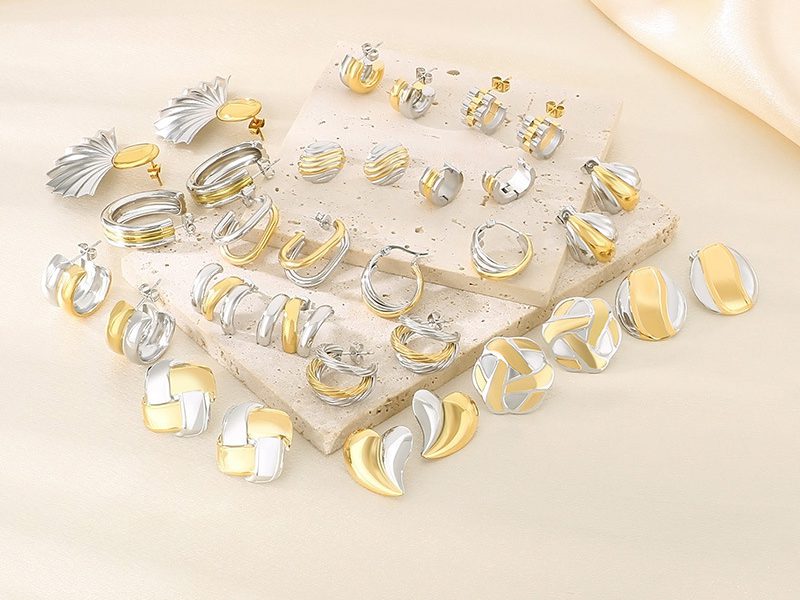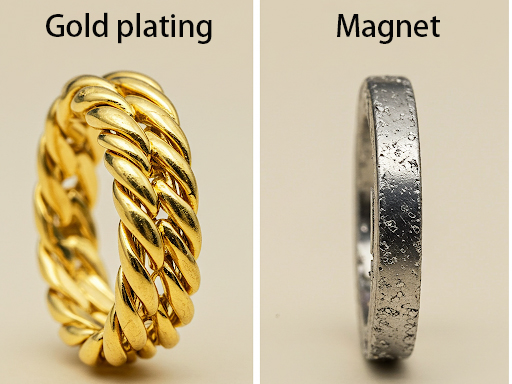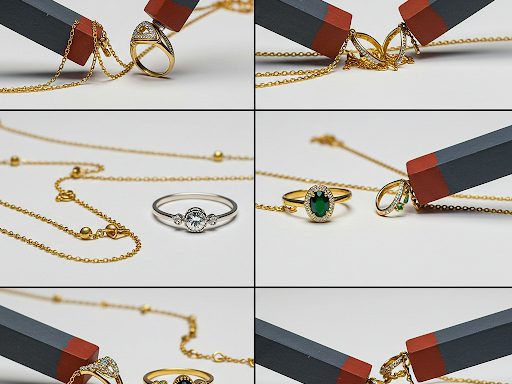
Blog
Is Gold Filled Magnetic? How to Spot Magnetic Gold Filled Jewelry

Is Gold Filled Magnetic?How to Spot Magnetic Gold Filled Jewelry

I sometimes see customers shocked when their “gold filled” pieces cling to a magnet. This confusion triggers lost trust and unexpected returns.
Authentic gold filled jewelry is typically non-magnetic if it uses copper or brass as its base. When you find magnetism, it often reveals nickel or steel underlayers, causing brand risks and legal pitfalls.
I recall a Dutch wholesaler who faced fines for unknowingly selling magnetic “gold filled” chains containing nickel. That story taught me strict supplier verification is critical.
Why Should Gold Filled Jewelry Be Non-Magnetic?
Gold filled items bond a thick gold layer (usually 5% or more by weight) onto non-ferrous metals like brass or copper. Neither brass nor copper reacts to magnets.
Real gold filled pieces use non-magnetic metals, so they should not cling to magnets. A well-bonded gold layer ensures premium aesthetics without magnet issues.
Dive Deeper: The Physics Behind It
- Base Metals: Brass or copper have a magnetic permeability near 1.0, meaning zero attraction.
- Gold Content: A bonded layer of 10K, 14K, or 18K gold forms most of the outer surface.
- Bonding Method: High-pressure and heat fusing, not electroplating.
| Base Metal | Magnetic Response | Permeability (μ) |
|---|---|---|
| Brass (C260) | None | 1.000 |
| Pure Copper | None | 1.000 |
| Nickel Alloy | Strong | 50–100 |
| Steel (430) | Moderate | 600–1000 |
I always check material certificates to confirm the exact composition.
What Happens If Gold Filled Jewelry Attracts a Magnet?
When a gold filled piece is magnetic, it signals undisclosed metals in the base. That means potential compliance violations and higher return rates.
Magnetism often points to nickel or steel in the substrate. This lowers the gold ratio, can trigger allergies, and can land you in regulatory trouble.

Dive Deeper: Risks and Realities
- Fraudulent Base Metal: A cheaper nickel alloy disguised as brass.
- Mixed Scrap Metal: Uncontrolled melting processes produce random ferrous contamination.
- Legal Penalties: Violating the EU Nickel Directive or California Prop 65 can cost tens of thousands in fines.
| Defect Type | Compliance Risk |
|---|---|
| Nickel Undermetal | EU Nickel Directive |
| Lead Contamination | Prop 65 (California) |
| Fake Gold Layer | FTC Gold Labeling |
I’ve seen entire shipments seized due to incorrect labeling.
How to Test for Magnetism and Fraud?
I recommend a four-step QC approach for every batch, which has saved me from expensive surprises.
A basic magnet test reveals hidden ferrous metals. Follow up with XRF analysis and standardized wear tests to confirm authenticity.

Dive Deeper: Step-by-Step QC
- Visual Inspection: Check for inconsistencies in color or plating thickness.
- Magnet Screen: A simple magnet determines if the item responds.
- XRF Validation: Confirms base metal composition within 0.05% tolerance.
- Wear Simulation: Salt spray (ASTM B117) and sweat tests ensure bonding durability.
| QC Stage | Cost per 1000 | Risk Prevention |
|---|---|---|
| Magnet Test | $18 | High |
| XRF Analysis | $75 | Critical |
Combining these tests lowers overall QA spend by catching problems early.
Are There Legitimate Uses of Magnetism in Gold Jewelry?
Some designs incorporate magnets, yet typically not in the entire chain or ring structure. Instead, they focus on clasps or novelty pendants.
Adding magnets can be done responsibly if clearly disclosed, using only the clasp for easy wearing. The rest of the piece remains non-magnetic.
Dive Deeper: Safe Magnetic Components
- Magnetic Clasps: REACH Annex XVII-compliant, no contact with the user’s skin beyond normal wear.
- Temporary Magnetic Plating: Rare but possible for novelty or healing claims, regulated in some regions.
- Stand-Alone Attachments: Removable magnets that do not alter the entire jewelry base.
| Component | Allowed Magnetism | Regulation |
|---|---|---|
| Clasp | Permitted | REACH Annex XVII |
| Pendant Bail | Limited | CPSC 16 CFR 1303 |
| Full Chain | Banned in EU | Nickel Directive |
Conclusion
Gold filled jewelry should not attract magnets if manufactured properly with non-ferrous metals. To maintain trust and protect your brand, verify suppliers’ metal composition through rigorous QC. If you need magnets for functionality, limit them to discreet clasps.
Kalen | Gold Filled Specialists
⛓ Guaranteed Non-Magnetic Base | 📜 ISO 9001/SEDEX Certified
🔍 Free XRF Report per Order | ⚡ MOQ 200 Pieces
✉️ info@kalenstore.com | 📱 +86 133 8080 9693
